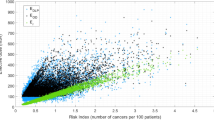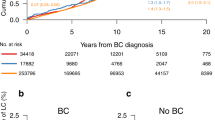Abstract
The use of CT in the US has been increasing exponentially over the past decade. The greatest increases in CT use have been in pediatric diagnosis and adult screening. Unfortunately, there is little cognizance among health-care providers (or their patients) about the relative latent cancer risks associated with repetitive exposure to ionizing radiation. Given the exposure of a relatively high proportion of the population to these tests, it is incumbent on health-care providers to have an improved understanding of these risks and discuss them accordingly with their patients. The risks and benefits of these tests should be carefully analyzed and radiation exposure risk assessment should be conducted as part of the selection of diagnostic and screening tests. Appropriate discussion between physicians and patients of the risks associated with radiographic studies is warranted to inform patients of the longitudinal risks of subsequent testing.
This is a preview of subscription content, access via your institution
Access options
Subscribe to this journal
Receive 12 print issues and online access
$209.00 per year
only $17.42 per issue
Buy this article
- Purchase on Springer Link
- Instant access to full article PDF
Prices may be subject to local taxes which are calculated during checkout
Similar content being viewed by others
References
Ulrich, H. Incidence of leukemia in radiologists. N. Engl. J. Med. 234, 742–743 (1946).
Fazel, R. et al. Exposure to low-dose ionizing radiation from medcial imaging procedures. N. Engl. J. Med. 361, 849–857 (2009).
IMV CT 2006 market summary report. IMV [online], (2006).
Linton, O. W. & Mettler, F. A. Jr. National conference on dose reduction in CT with an emphasis on pediatric patients. Am. J. Roentgenol. 181, 321–329 (2003).
Brenner, D. J. & Georgsson, M. A. Mass screening with CT colonography: should the radiation exposure be of concern? Gastroenterology 129, 328–337 (2005).
Bach, P. B. et al. Computed tomography screening and lung cancer outcomes. JAMA 297, 953–961 (2007).
Brenner, D. J. & Elliston, C. D. Estimated radiation risks potentially associated with full body CT screening. Radiology 232, 735–738 (2004).
Little, M. P. Risk associated with ionizing radiation. Br. Med. Bull. 68, 259–275 (2003).
Shope, T. B. Radiation-induced skin injuries from fluoroscopy. Radiographics 16, 1195–1199 (1996).
International Commission on Radiological Protection. Recommendations of the International Commission on Radiological Protection publication 60 (Pergamon Press, Oxford, 1991).
Löbrich, M. et al. In vivo formation and repair of DNA double-strand breaks after computed tomography examinations. Proc. Natl Acad. Sci. USA 102, 8984–8989 (2005).
Committee to Assess the Health Risks from Exposure to Low Levels of Ionizing Radiation. Health risks from exposure to low levels of ionizing radiation: BEIR VII phase 2. The National Academies Press [online]
Liedenbaum, M. H., Venema, H. W. & Stoker, J. Radiation dose in CT colonography–trends in time and differences between daily practice and screening protocols. Eur. Radiol. 18, 2222–2230 (2008).
Katz, S. I., Saluja, S., Brink, J. A. & Forman, H. P. Radiation dose associated with unenhanced CT for suspected renal colic: impact of repetitive studies. Am. J. Roentgenol. 186, 1120–1124 (2006).
Hausleiter, J. et al. Estimated radiation dose associated with cardiac CT angiography. JAMA 301, 500–507 (2009).
Brenner, D. J. & Hall, E. J. Computed tomography—an increasing source of radiation exposure. N. Engl. J. Med. 357, 2277–2278 (2007).
Preston, D. L. et al. Effect of recent changes in atomic bomb survivor dosimetry on cancer mortality risk estimates. Radiat. Res. 162, 377–389 (2004).
Preston, D. L. et al. Solid cancer incidence in atomic bomb survivors: 1958–1998. Radiat. Res. 168, 1–64 (2007).
Cardis, E. et al. The 15-country collaborative study of cancer risk among radiation workers in the nuclear industry: estimates of radiation-related cancer risks. Radiat. Res. 167, 396–416 (2007).
Einstein, A. J., Henzolova, M. J. & Rajagopalan, S. Estimating risk of cancer associated with radiation exposure from 64-slice computed tomography coronary angiography. JAMA 298, 317–323 (2007).
Lee, C. I., Haims, A. H., Monico, E. P., Brink, J. A. & Forman, H. P. Diagnostic CT scans: assessment of patient, physician and radiologist awareness of radiation dose and possible risks. Radiology 231, 393–398 (2004).
Morcos, S. K. Prevention of contrast media-induced nephrotoxicity after angiographic procedures. J. Vasc. Interv. Radiol. 16, 13–23 (2005).
United Nations Scientific Committee on the Effects of Atomic Radiation. Sources and effects of ionizing radiation. UNSCEAR [online]
U. S. Preventive Services Task Force. Screening for colorectal cancer. Ann. Intern. Med. 149, 1–44 (2008).
Berrington de Gonzales, A. & Darby, S. Risk of cancer from diagnostic x-rays: estimates for the UK and 14 other countries. Lancet 363, 345–351 (2004).
Slovis, T. L. & Berdon, W. E. Panel discussion. Pediatr. Radiol. 32, 242–244 (2002).
American Medical Association. Informed Consent [online]
Canterbury v Spence, 464 F.2d 772, 780 n 15 (D. C. Cir. 1972).
Author information
Authors and Affiliations
Corresponding author
Ethics declarations
Competing interests
The authors declare no competing financial interests.
Rights and permissions
About this article
Cite this article
Johnson, D., Helft, P. & Rex, D. CT and radiation-related cancer risk—time for a paradigm shift?. Nat Rev Gastroenterol Hepatol 6, 738–740 (2009). https://doi.org/10.1038/nrgastro.2009.184
Issue Date:
DOI: https://doi.org/10.1038/nrgastro.2009.184
This article is cited by
-
Indecent exposures
Nature Reviews Gastroenterology & Hepatology (2009)



